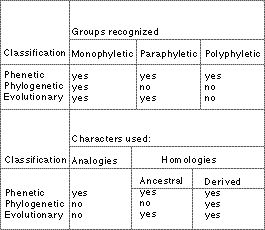Classification and evolution - What are the three main schools of classification?

Taxonomic terms
A monophyletic group is a group which contains all the descendants of a common ancestor: the group has a common ancestor unique to itself. It is the only group recognized by cladist classification. Monophyletic groups contain all the branches below a given ancestor; nothing is said about the phenetic evolution of species within each branch.
A paraphyletic group contains some, but not all, of the descendants from a common ancestor. The members included are those that have changed little from the ancestral state; those that have changed more are excluded: a paraphyletic group contains the rump of conservative descendants from an ancestral species.
Polyphyletic groups are formed when two lineages convergently evolve similar character states. Organisms classified into the same polyphyletic group share phenetic homoplasies as opposed to homologies.
The following animation shows the differences between them.
Table: phenetic, evolutionary and cladistic classification can be distinguished by the characters they use to define groups, and the kinds of groups they recognize.
| Next |



